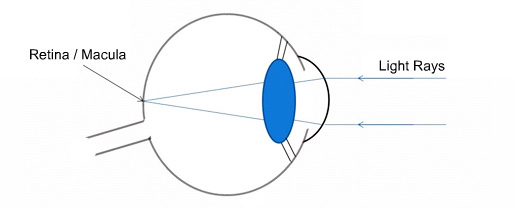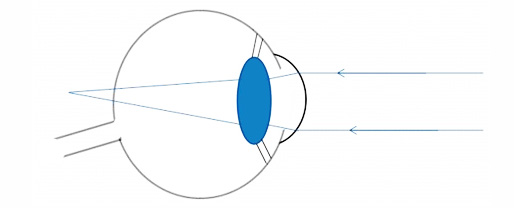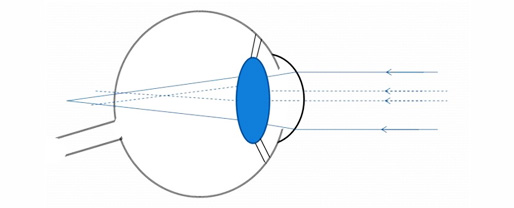
Definition
The images perceived by the eyes are only the light reflected by the objects. This light is processed by a nervous membrane of the eye, the retina, which functions like a photographic film. The beams of light entering the eye are parallel among them, but to be processed by the retina they have to be focused converging on it.
 |
Emetropia: the beams of light focus onto the retina.
The eye has an optical system that, in normal conditions, enables the automatic focusing of the light beams in the right position. When this is not the case, there is a refractive error.
There are three main types of refractive errors.
Hypermetropia
Light rays converge behind the retina, as if the eye was too small or the focusing system was too weak. As the vision of near objects requires more effort in focusing than the vision of distant objects, the first difficulty is in near vision. Within certain values and in young individuals far vision can be normal.
 |
Hypermetropia: the beams of light focus behind the retina.
Myopia
Light rays converge in front of the retina, as if the eye was too large or the focusing system was too strong. As near vision requires more effort in focusing than far vision, myopic individuals have clear near vision, even without corrective lenses, but their vision of distant objects is indistinct.
 |
Myopia: the beams of light focus in front of the retina.
Astigmatism
Light rays do not converge all on the same plane: they focus on different planes according to the position (meridian) when entering the eye. The eye has not a spherical shape, where all meridians have equal curvatures. It is elongate and one of its meridians has a different curvature. Astigmatism causes blurred vision at far and at near.
 |
Astigmatism: the beams of light for different meridians focus on different planes
Demographic data and clinical significance
Refractive errors are present in a large percentage of the world population. Apart the differences concerning age, sex and race, it was estimated that more than 50% of all the population suffer from a refractive error.
Refractive errors are easy to diagnose, to measure and to correct with appropriate optical means, in order to provide normal visual acuity. But in countries where they are not properly treated, they become an important cause of defective eyesight, with immediate consequences and long term effects in children and in adults.
The visual deficit, resulting from uncorrected refractive errors, impairs learning and work productivity, and thus reduces the capacities and the quality of life of the affected individuals.
HYPERMETROPIA
Hypermetropia is normally present at birth, decreasing progressively in the first 3 – 4 years of life.
Considering all the values of hypermetropia, its prevalence is 37% in children between 3 and 8 years old and 29.5% between 9 and 19 years old. However, taking into account only values over 1.50 D, its prevalence drops to 4 – 7% between 5 and 29 years old.
In children, the prevalence of hypermetropia is higher among Caucasians, followed by Hispanics, Afro-Americans and Asians. There is a curious study (Crawford’s) that shows the existence of a higher prevalence of hypermetropia among the children of Portuguese origin, comparatively to all the other groups.
The prevalence of hypermetropia is constant during middle age and increases over the age of 45 years.
Weak hypermetropia seems to be hereditary autosomal dominant, while strong hypermetropia seems autosomal recessive.
Hypermetropia, not corrected, is responsible for about 80% of the cases of convergent strabismus detected between the ages of 2 and 4 years. Unlike in case of myopia, the optical system of the eye is able to compensate, within certain limits, the hypermetropic focusing deficit. This excessive focusing effort is often associated with an abnormal increase of convergence causing strabismus. Therefore, in case of suspicion of the presence of hypermetropia, it should be accurately measured with the aid of eye drops.
MYOPIA
In general, its prevalence varies with age, sex and race.
Myopia increases in the first decades of life, particularly during late childhood and adolescence. It is present in 1% of children aged 5, rising to 8% of those aged 10 and 15% of those aged 15. It is a little more frequent in female children.
In an epidemiological study carried out in Valencia (Spain), myopia prevalence was 2.5% in children with ages between 3 and 8 years, rising to 25.7% in those between 9 and 19 years old.
The prevalence of myopia is very variable according to the ethnic group: Asians have the highest prevalence, followed by Hispanics; Afro-Americans and Caucasians have a lower prevalence.
There are several factors of risk for the presence of myopia in a child. A very important one is the existence of a family history of myopia. Myopia prevalence is 20 – 40% in case of one myopic parent and 30 – 60% when both parents are myopic. Another factor of risk is the absence of hypermetropia or the presence of a hypermetropia inferior to 0.50 D in preschool age. The excessive use of near vision, including frequent and continuous reading, is also apparently a factor of risk.
In most cases, myopia is simple type and progresses at a variable pace during childhood and adolescence not surpassing 6.00 D.
Degenerative myopia is rarer, with values above 6.00 D, and presents frequently alterations of the retina that can cause visual troubles.
ASTIGMATISM
It is probably the most frequent refractive error. Considering all the values of astigmatism, its prevalence is superior to 70%.
For values above 1.00 D, the prevalence of astigmatism in children is about 28%.
In terms of ethnic groups, it is more frequent in Hispanics, followed by Asians, Caucasians and Afro-Americans.
During childhood, the prevalence of astigmatism does not vary with age, unlike hypermetropia prevalence that decreases with age and myopia prevalence that increases with age.
Normally it is caused by an irregularity of the cornea shape, and more rarely of the crystalline lens. As these irregularities displace the focus only for one meridian, the focusing for that meridian is positioned on a plane different from the rest, blurring the final image of near and distant objects.
Fortunately, the majority of astigmatisms are very weak, and so they do not produce significant visual alterations; yet they can cause visual fatigue and headaches, and in these cases they should be perfectly corrected.
In the absence of a traumatism or an eye disease, the causes of astigmatism are unknown: it may be hereditary, existing already at birth. Though in most cases it remains more or less stable, it may increase or decrease with the child’s growth.

